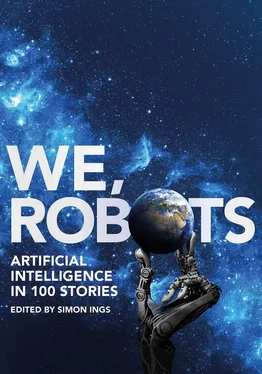ARTIFICIAL INTELLIGENCE IN 100 STORIES
EDITED BY SIMON INGS
for Leo,
my favourite steam-driven boy
It appeared near the Houses of Parliament on Wednesday 9 December 1868. It looked for all the world like a railway signal: a revolving gas-powered lantern with a red and a green light at the end of a swivelling wooden arm.
Its purposes seemed benign, and we obeyed its instructions willingly. Why wouldn’t we? The motor car had yet to arrive, but horses, pound for pound, are way worse on the streets, and accidents were killing over a thousand people a year in the capital alone. We were only too welcoming of of anything that promised to save lives.
A month later the thing (whatever it was) exploded, tearing the face off a nearby policeman.
We hesitated. We asked ourselves whether this thing (whatever it was) was a good thing, after all. But we came round. We invented excuses, and blamed a leaking gas main for the accident. We made allowances and various design improvements were suggested. And in the end we decided that the thing (whatever it was) could stay.
We learned to give it space to operate. We learned to leave it alone. In Chicago, in 1910, it grew self-sufficient, so there was no need for a policeman to operate it. Two years later, in Salt Lake City, Utah, a detective (called – no kidding – Lester Wire) connected it to the electricity grid.
It went by various names, acquiring character and identity as its empire expanded. By the time its brethren arrived In Los Angeles, looming over Fifth Avenue’s crossings on elegant gilded columns, each surmounted by a statuette, ringing bells and waving stubby semaphore arms, people had taken to calling them robots .
The name never quite stuck, perhaps because their days of ostentation were already passing. Even as they became ubiquitous, they were growing smaller and simpler, making us forget what they really were (the unacknowledged legislators of our every movement). Everyone, in the end, ended up calling them traffic lights.
(Almost everyone. In South Africa, for some obscure geopolitical reason, the name robot stuck, The signs are everywhere: Robot Ahead 250m . You have been warned.)
In Kinshasa, meanwhile, nearly three thousand kilometres to the north, robots have arrived to direct the traffic in what has been, for the longest while, one of the last redoubts of unaccommodated human muddle.
Not traffic lights: robots . Behold their bright silver robot bodies, shining in the sun, their swivelling chests, their long, dexterous arms and large round camera-enabled eyes!
Some government critics complain that these literal traffic robots are an expensive distraction from the real business of traffic control in Congo’s capital.
These people have no idea – none – what is coming.
* * *
To ready us for the inevitable, here are a hundred of the best short stories ever written about robots and artificial minds. Read them while you can, learn from them, and make your preparations, in that narrowing sliver of time left to you between updating your Facebook page and liking your friends’ posts on Instagram, between Netflix binges and Spotify dives. (In case you hadn’t noticed (and you’re not supposed to notice) the robots are well on their way to ultimate victory, their land sortie of 1868 having, two and a half centuries later, become a psychic rout.)
There are many surprises in store in these pages; at the same time, there are some disconcerting omissions. I’ve been very sparing in my choice of very long short stories. (Books fall apart above a certain length, so inserting novellas in one place would inevitably mean stuffing the collection with squibs and drabbles elsewhere. Let’s not play that game.) I’ve avoided stories whose robots might just as easily be guard dogs, relatives, detectives, children, or what-have-you. (Of course, robots who explore such roles – excel at them, make a mess of them, or change them forever – are here in numbers.) And the writers I feature appear only once, so anyone expecting some sort of celebrity bitch-slap here between Isaac Asimov and Philip K. Dick will simply have to sit on their hands and behave. Indeed, Dick and Asimov do not appear at all in this collection, for the very good reason that you’ve read them many times already (and if you haven’t, where have you been ?).
I’ve stuck to the short story form. There’s no Frankenstein here, and no Tik-Tok . They were too big to fit through the door, to which a sign is appended to the effect that I don’t perform extractions. Jerome K. Jerome’s all-too-memorable dance class and Charles Dickens’s prescient send-up of theme parks – self-contained narratives first published in digest form – are as close as I’ve come to plucking juicy plums from bigger puddings.
This collection contains the most diverse collection of robots I could find. Anthropomorphic robots, invertebrate AIs, thuggish metal lumps and wisps of manufactured intelligence so delicate, if you blinked you might miss them. The literature of robots and artificial intelligence is wildly diverse, in both tone and intent, so to save the reader from whiplash, I’ve split my 100 stories into six short thematic collections.
It’s Alive! is about inventors and their creations.
Following the Money drops robots into the day-to-day business of living.
Owners and Servants considers the human potentials and pitfalls of owning and maintaining robots.
Changing Places looks at what happens at the blurred interface between human and machine minds.
All Hail The New Flesh waves goodbye to the physical boundaries that once separated machines from their human creators.
Succession considers the future of human and machine consciousnesses – in so far as they have one.
* * *
What’s extraordinary, in this collection of 100 stories, are not the lucky guesses (even a stopped clock is right twice a day), nor even the deep human insights that are scattered about the place (though heaven knows we could never have too many of them ). It’s how wrong these stories are. All of them. Even the most prescient. Even the most attuned. Robots are nothing like what we expected them to be. They are far more helpful, far more everywhere, far more deadly, than we ever dreamed.
They were meant to be a little bit like us: artificial servants – humanoid, in the main – able and willing to tackle the brute physical demands of our world so we wouldn’t have to. But dealing with physical reality turned out to be a lot harder than it looked, and robots are lousy at it.
Rather than dealing with the world, it turned out easier for us to change the world. Why buy a robot that cuts the grass (especially if cutting grass is all it does) when you can just lay down plastic grass? Why build an expensive robot that can keep your fridge stocked and chauffeur your car (and, by the way, we’re still nowhere near to building such a machine) when you can buy a fridge that reads barcodes to keep the milk topped up, while you swan about town in an Uber?
That fridge, keeping you in milk long after you’ve given up dairy; the hapless taxi driver who arrives the wrong side of a six-lane highway; the airport gate that won’t let you into your own country because you’re wearing new spectacles: these days, we notice robots only when they go wrong. We were expecting friends, companions, or at any rate pets. At the very least, we thought we were going to get devices. What we got was infrastructure .
Читать дальше








